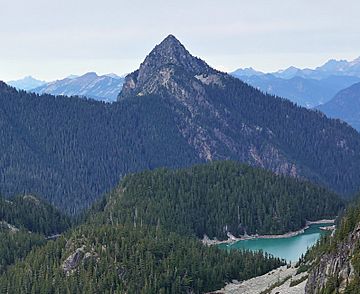Bald Eagle Peak facts for kids
Quick facts for kids Bald Eagle Peak |
|
|---|---|

South aspect
|
|
| Highest point | |
| Elevation | 6,259 ft (1,908 m) |
| Prominence | 1,019 ft (311 m) |
| Isolation | 2.75 mi (4.43 km) |
| Parent peak | Otter Point (6,359 ft) |
| Geography | |
| Location | Alpine Lakes Wilderness King County, Washington state, U.S. |
| Parent range | Cascade Range |
| Topo map | USGS Big Snow Mountain |
| Climbing | |
| First ascent | 1933 Hermann Ulrichs, Ben Falkenburg |
| Easiest route | class 3 scrambling North Ridge |
Bald Eagle Peak is a tall mountain in Washington state. It stands about 6,259 feet (1,908 meters) high. You can find it about 7.4 miles (11.9 km) southeast of Skykomish. This peak is part of the Cascade Range, a big mountain chain. It is located in the Alpine Lakes Wilderness area. The land around it is managed by the Mount Baker-Snoqualmie National Forest.
Water flowing from this mountain goes into the Foss River. Bald Eagle Peak sits between the east and west forks of the Foss River. A nearby mountain is Silver Eagle Peak, about 1.1 miles (1.8 km) away. There's also Bald Eagle Lake between these two peaks. The first people to climb Bald Eagle Peak were Hermann Ulrichs and Ben Falkenburg in 1933. They climbed it using the North Ridge. The mountain's name was officially recognized in 1988.
Weather at Bald Eagle Peak
Bald Eagle Peak is in a "marine west coast" climate zone. This means it gets a lot of rain and snow. Most weather comes from the Pacific Ocean. These weather systems move towards the Cascade Mountains. When they hit the mountains, the air is forced to rise. This makes the air cool down and drop its moisture as rain or snow. This process is called orographic lift.
Because of this, the west side of the Cascade Mountains gets a lot of precipitation. In winter, there is heavy snowfall. The snow can be wet and heavy, which can cause avalanches. During winter, it's often cloudy. But in summer, high pressure systems over the Pacific Ocean bring clear skies. The best time to visit or climb Bald Eagle Peak is usually from July to September.
How the Mountains Formed
The Alpine Lakes Wilderness has very rugged land. You can see jagged peaks, deep valleys carved by glaciers, and tall granite walls. There are also over 700 mountain lakes. All these different features were created by geological events that happened millions of years ago. These events caused big changes in the land's height and led to different climates.
The Cascade Range started forming millions of years ago. This happened when the North American Plate slowly moved over the Pacific Plate. This movement caused volcanoes to erupt over a long time. Also, small pieces of the Earth's crust, called terranes, joined together. This helped create the North Cascades about 50 million years ago.
Later, during the Pleistocene period (which started over two million years ago), huge sheets of ice called glaciers moved across the land. These glaciers moved forward and backward many times. They carved and shaped the landscape. The last glaciers in the Alpine Lakes area started melting about 14,000 years ago. They were gone from the area by 10,000 years ago. The "U"-shaped valleys you see today were formed by these glaciers. The combination of land uplift, faults (cracks in the Earth's crust), and glaciers created the tall peaks and deep valleys of the Alpine Lakes Wilderness.



